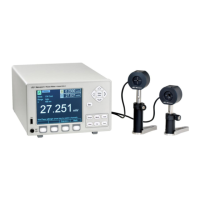66 Performing Basic Measurements
This process assumes that the ambient signal is not changing between the
time when the Zero key is pressed and when the measurement is made. The
user should remember that, if he/she can see the detector active area as he/she
moves around, then the detector registers this as a changing ambient DC
signal.
For the 918D series detectors (also 818-XX low power detectors with proper
adapters) you can decide whether to use the attenuator for your measurement
or deactivate (or physically remove on 818 low power series) the attenuator.
For very low power measurements, pW to µW range in various ambient light
environments, you can elect to use the detector with no physical attenuator in
the optical path. This will increase the sensitivity and hence accuracy of the
measurement.
In case of higher power measurement with the 918D (or 818-XX) detector,
the attenuator should be used to avoid damage or saturation of the detector.
The attenuator use is recommended in mW to low Wattage range incident
power. Please refer to the specifications of the particular detector to make
sure you do not exceed the saturation levels of the detector.
For the 918D series detectors with integrated (non-removable) attenuators,
there is a switch built into the detector head, sensing the position of the
attenuator. The power meter will then automatically use proper calibration
data for presence or absence of the attenuator in front of the photo diode. For
models such as 818 low power series detectors which have a removable
attenuator, there is no switch built into the detector head, hence the user will
have to manually select attenuator option status on the meter to obtain the
proper power or signal readings.
5.4 Peak-to-Peak Power Measurements (918D Detectors)
This section describes the procedure for making basic optical peak-to-peak
power measurements.
With a 918D Low Power Detector connected to the meter, turn the meter on.
Set the Mode to Pk-Pk Continuous. Set Range to Auto and press the Lambda
(λ) key to set the measurement wavelength to the desired value.
Illuminate the detector and note the displayed value. This reading is the peak-
to-peak optical power observed by the detector.
Accurate peak-to-peak power measurements can be made for pulse repetition
rates up to 20 kHz.
5.5 Power Ratio and Power Reference Measurements
This section describes how to use the mathematical functions in the power
meter to obtain dB, Power or signal comparison, or ratio measurements.

